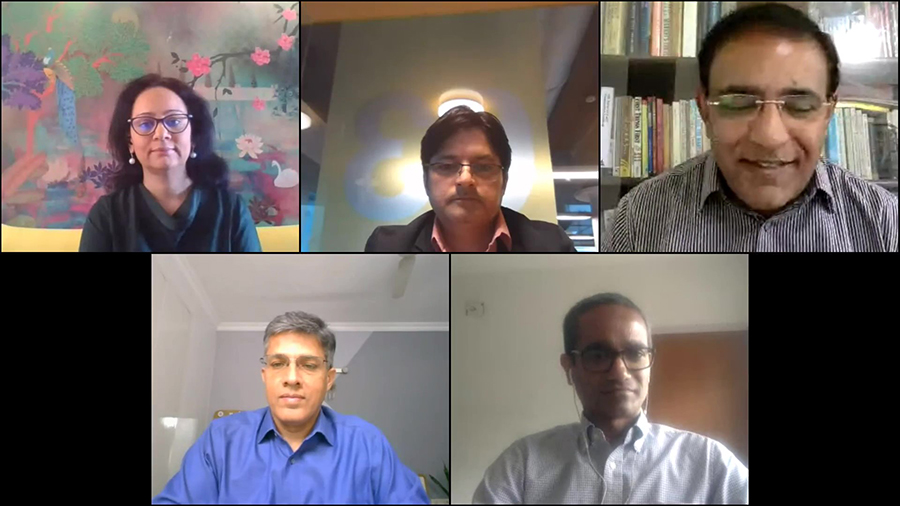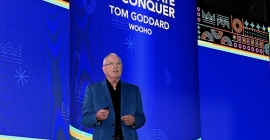Conditions right for India to become a major DOOH market in next few years: OOH leaders
By M4G Bureau - July 02, 2021
Aman Nanda, Chief Strategy Officer, Times Innovative Media Ltd, Shoumitro Goswami, Co-Founder, Vyoma, Fabian Cowan, India Head, Posterscope, Vinkoo Chakraborty, Business Head, Rapport India shared their perspectives on the theme of ‘Driving Digital Growth’ at Quividi India Conference

The Quividi India Conference, held on an online platform on June 29, 2021, opened with a session on the theme ‘Driving Digital Growth’, addressed by Aman Nanda, Chief Strategy Officer, Times Innovative Media Ltd, Shoumitro Goswami, Co-Founder, Vyoma, Fabian Cowan, India Head, Posterscope, Vinkoo Chakraborty, Business Head, Rapport India, and anchored by Rajiv Raghunath, Managing Editor, Media4Growth and Outdoor Asia.
At the outset, the panelists shared their observations on the potential of India emerging as the next global DOOH giant. Vinkoo remarked that although DOOH accounts for only about 4% of India’s OOH industry, as compared to an average 20% in the more developed markets, over the last 1-2 years Indian OOH markets have witnessed increased digitisation across environments, growing presence of programmatic DOOH players, and high smartphone penetration - that would contributed to the growth of DOOH audiences.
“India can become the next big player in DOOH, if we drive OOH, DOOH & pDOOH together seamlessly, Vinkoo said, while adding that the stumbling blocks in the growth path are (i) lack of reach across consumer cohorts, as the current DOOH scale is rather limited, (ii) technology infrastructure that is currently not sufficiently developed, (iii) lack of standardisation of the processes and protocols, (iv) lack of standardised audience measurement metrics, (v) fragmented ownership of media, and (vi) stringent regulatory curbs on roadside DOOH displays.
Highlighting some of the other DOOH growth factors, Fabian referred to retail media – with large retailers monetising screens at the outlets to third party advertisers. EV charging stations could also become potentially major DOOH advertising destinations, he said, while pointing out that India currently has 1,800 EV charging stations that is expected to grow to 400,000 stations in the next 5 years.
Responding to a question on how brands perceive DOOH, Fabian said that would depend on the outlook of individual brands, and their objectives. “OTT brands, for instance, are making great use of D/OOH,” he said. However, some brands that are only investing “left over” budgets might want to have access to more audience data to invest significantly in the D/OOH market, and create ads that are not just repurposed from another media but tailored to engage an OOH audience.
Citing other DOOH growth enabling factors, Fabian said “the interesting part is that soon India will be entering the 5G phase, resulting in superfast connectivity. With download speeds increasing at will, connected screens can be used by advertisers to upload contextual content in real time, thereby minimising go-to-market lead times significantly. This will forever change the way brands contact, connect, and converse with audiences.”
Sharing his perspectives on the theme of the session, Aman emphatically stated that India is well poised to become the next DOOH giant. “I am confident because India has all the necessary ingredients needed for digital OOH to become a success. The country has a large urban population – 40% of India’s population (600 million) will be urbanised by 2030; young audiences with high disposable income. The metros are now crowded and there is scarcity of finding good OOH location – so digital can help in increasing the inventory; technology is available – hardware, software and high-speed internet – that offers flawless connectivity and the recent investments being made on the programmatic side; and there is burst in infrastructure projects – 200 airports are being developed, luxury malls are mushrooming everywhere, Metro rails are coming up in 20 plus towns, smart city projects are gaining ground.”
Aman asserted that the Indian OOH market will reach the global level of 20-25% DOOH spends in next 5 years in India. “I also see that post-Covid, the absorption of DOOH will increase. We have observed that when lockdown was lifted and things were getting normalised, DOOH got lot of traction due to its dynamic media capability, lesser turnaround time , no printing mounting cost and lesser ticket size. Brands can afford best of the best locations at lesser price due to slot-based media pricing,” he said.
From Shoumitro’s perspective, there 3 big factors that will push the Indian DOOH market over the tipping point:
- Cost of rolling out large DOOH networks is falling
- Revenue monetisation is increasing as brands realise the power and possibilities of a ‘Connected DOOH Network’
- Massive push in new infrastructure in public & private domain – airports, railways, metro rail, road transportation, retail, EV charging stations etc.
Shoumitro added that ‘attribution’ is vital to the DOOH growth. “As an industry if we can find a methodology to ‘attribute’ a consumer action because of our medium, it will be a game changer. Over the next 5 years India has the potential to be amongst the largest DOOH markets globally,” he said, a view shared by all panel speakers in the session.

Stay on top of OOH media trends

-2_140_270.png)






